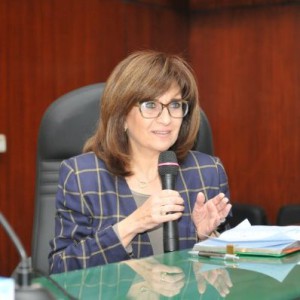The Ecocity World Summit in Abu Dhabi will take place October 11-13th of 2015
 Dr. Sahar Attia is a Professor at the Faculty of Engineering at Cairo University, with a PhD in Urban Planning from the Urban Institute of Paris, University of Paris 12, France. She has more than 30 Years of experience practicing Urban Planning, Urban Design, and Architecture in the Academic and Professional Field. Her specializations and fields of interest include Urban Development & strategic Planning, Heritage Conservation and Urban Regeneration, Upgrading the informal areas, with special focus on public space. She has been doing consultancy work for both, public and private sector.
Dr. Sahar Attia is a Professor at the Faculty of Engineering at Cairo University, with a PhD in Urban Planning from the Urban Institute of Paris, University of Paris 12, France. She has more than 30 Years of experience practicing Urban Planning, Urban Design, and Architecture in the Academic and Professional Field. Her specializations and fields of interest include Urban Development & strategic Planning, Heritage Conservation and Urban Regeneration, Upgrading the informal areas, with special focus on public space. She has been doing consultancy work for both, public and private sector.
1. What do you find most interesting about the Ecocity concept (cities in balance with nature and culture)?
The first time I was introduced to the original concept of the Ecocity was in the early eighties in a postgraduate course entitled “Urban Ecology”, taught by one of our greatest environmentalists in Egypt, Prof. Bahaa Bakry. He conveyed to all of his students, including myself, the understanding of the importance of Ecology and the relationship between the citizen, nature and architecture. Since architecture and planning are the interpretation of citizens’ culture, these basics were essential for understanding the evolution of the concept.
What is interesting is the relationship between urban ecology concerns –later developed into the Ecocity concept– and the city as a product, especially in developing countries. In fact, although governments now are more aware of the importance of the concept, conditions are still worsening in many cities. In addition, although environmentalists and planners are now speaking the same language, using the same terminologies, and aspiring for the same goals, still the urban product is not providing healthy, and safe urban environments.
Moreover, Ecocities involve many issues and aspects related to land development, land uses, energy, technology, architecture, pollution, urban sprawl, transportation, green public spaces, regulations, slums, recycling, water…and many more. Combining multidisciplinary approaches all linked to each other require continuous research to find adequate solutions for the challenges they pose to enable a better decision making process. The will of governments to produce Ecocities needs to be supported by the will of citizens. Hence awareness and behavioral patterns should be addressed, especially in developing countries, to establish the balance between nature and culture.
2. What are you going to be talking about at Ecocity World Summit ’15 in Abu Dhabi?
Since my involvement in the Ecocity summits, and the new urban agenda to be declared in Habitat III, my major concern is to search for new approaches to design eco-friendly sustainable cities. I will address how to rethink the design of cities’ components, specifically streets and public spaces. The main idea I will be tackling in the next summit is eco-public space in the new urban agenda with special focus on developing countries and the paradigm shift that must take place to produce eco-spaces, stressing on the role Public spaces can play in stabilizing the collective identity,and re-injecting social inclusiveness in cities. The major question that I will raise is related to culture versus public space design, and citizen’s practices. Some international ideas will guide the presentation such as UN Habitat principles and Future of Places Media Lab. The urban space is now in the core of the literature of cities. It is now integrated in texts/projects at all levels, rather than becoming an output or product, it is becoming the arena of many practices. Therefore it deserves attention, and good design.
3. What do you hope to learn about at Ecocity World Summit ’15?
I attended my first Ecocity Summit in San Francisco in 2008. Since then, the Ecocity World Summit has been a resource of information and inspiration leading my research interests and introducing new material in teaching my classes. I hope that during the next summit I will learn more about best practices of localized actions in different contexts focused on regulations, innovative institutional approaches that can be applied in developing countries to promote ecocities, and what capacities need to be built with regard to climate change issues. It would be interesting to hear about the relationship between climate change impacts and the cities’ settings and designs. Are there new guidelines to follow when designing coastal cities? Are the current methodologies relevant? And how can the World Summit feed the new U.N. urban agenda? It is important that all international activities relate to each other. Finally, it will be interesting to know how experts, and speakers view the future of ecocities considering the gap between developed, and developing countries. A new concept of inclusion at the global level is essential–all countries on our planet should have the advantage of including ecocities.
4. What are some ecocity elements in the city you live in?
Cairo in its current state cannot be categorized as an Ecocity. It is a large metropolitan agglomeration of 160,000 inhabitants facing many challenges. However, some elements of the ecocity are there, and that we can build on. The most important element is the willingness of the authorities to be aligned with the international trends regarding sustainability and “eco” thinking. Greater Cairo Region, or as we call it simply “Cairo,” still includes agricultural land (although it is suffering from encroachment). The Nile as a source of water, heritage and culture, is a great resource to consider. The current trends of creating public transportation facilities will be the greatest asset for Cairo to step in as an ecocity.
5. What is your definition of “eco-citizenship” (being an ecocitizen)?
Eco-citizenship can be defined as “getting involved in the welfare of the community”. Citizens need to learn how to measure their ecological status, how to evaluate the results, how to improve the below level measurements, and how to maintain the positive aspects. Measuring communities is like measuring the temperature of a human being; cities and communities are suffering environmental illness that should be taken care of by citizens. Eco-Citizenship means environmental responsibility: the sense of caring about nature, culture, saving energy, water, biodiversity, recycling, and all related aspects that would provide citizens a better quality of life.
6. What is your advice to young people who want to make their cities and neighborhoods more ecologically and socially healthy?
Young people nowadays are very creative. They should use this creativity in developing ideas to launch an awareness campaign about the positive sides of ecocities. I have to admit that this is a tough task, especially in urban poor areas where citizens are loaded with daily life concerns. Young people as well as older ones should come together to contribute in small initiatives and actions at the level of their communities, such as: volunteering in greening their neighborhoods, educating their neighbors, saving energy, promoting walkability and avoiding the excessive use of cars, encouraging carpooling, cycling, and waste recycling. Young people should be aware that all actions taken nowadays are essential for their future, and their families’ future, and it is the only way to make communities healthier to live in. However, young generations will need the support, and facilitation of NGOs, local governments, and schools, to enable them to achieve their innovative ideas. Saving the environment is a way of life so my final and main advice is to ”start with yourself”, set the example, and be the initiator. I recall here a quote from Albert Einstein “ Setting an example is not the main means of influencing others; it is the only means.”



Sorry, the comment form is closed at this time.